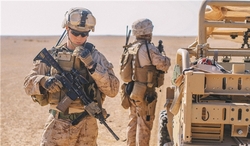 The United States says it will send troops to Saudi Arabia and the United Arab Emirates to bolster Riyadh's air defenses following a recent drone attack on two major oil facilities owned by Saudi state oil giant Aramco.
The United States says it will send troops to Saudi Arabia and the United Arab Emirates to bolster Riyadh's air defenses following a recent drone attack on two major oil facilities owned by Saudi state oil giant Aramco. RNA - The decision to send reinforcements to the region, which was approved by President Donald Trump on Friday, was made at the request of Saudi Arabia and the United Arab Emirates, according to the US Defense Department.
The Pentagon said the deployment would involve a moderate number of troops for what it called primarily “defensive in nature”.
"In response to the kingdom's request, the president has approved the deployment of US forces, which will be defensive in nature and primarily focused on air and missile defense," US Defense Secretary Mark Esper said at a news briefing.
"We will also work to accelerate the delivery of military equipment to the kingdom of Saudi Arabia and the UAE to enhance their ability to defend themselves."
The Pentagon has previously planned to send anti-missile batteries, drones and more fighter jets to the Persian Gulf too, according to Reuters. Washington is also considering keeping an aircraft carrier in the region indefinitely.
The new decision comes after Yemen’s Houthi Ansarullah fighters conducted strikes on the two facilities located in Abqaiq and Khurais on September 14. The attacks led to a halt in about 50 percent of the Arab kingdom’s crude and gas production, causing a surge in oil prices.
US Secretary of State Mike Pompeo quickly blamed Iran for the incident, with Trump saying later that the US was “locked and loaded” for a response at the behest of the Arab kingdom.
Tehran, however, rejected the accusations, calling them an attempt by the White House to shift from a failed campaign of “maximum pressure” to one of “maximum lying” and “deceit” against the Islamic Republic.
Meanwhile, US Marine General Joseph Dunford, chairman of the Joint Chiefs of Staff, said officials were still in the process of deciding what the best array of capabilities to defend Saudi Arabia is.
"No single system is going to be able to defend against a threat like that, but a layered system of defensive capabilities would mitigate the risk of swarms of drones or other attacks that may come from Iran," Dunford said.
Saudi Arabia and a number of its regional allies launched a devastating campaign against Yemen in March 2015, with the goal of bringing Yemen’s former regime back to power and crushing the Houthi movement, which significantly helping the Yemeni army in defending the country against invaders.
The latest attack came as Saudi Arabia, the world's top crude exporter, had been accelerating preparations for a much-anticipated initial public offering of Aramco.
847/940